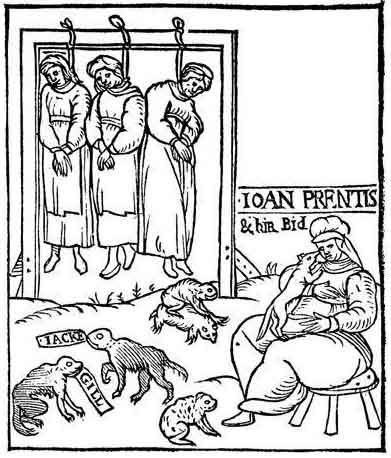
Wikimedia Commons
Essex witches is the collective name given to the thirty women and one man who were accused of witchcraft in the English county of Essex between 1566 and 1589, under the Witchcraft Act of 1563Series of Acts passed by the Parliaments of England and Scotland making witchcraft a secular offence punishable by death..[a]In England overall, 90 per cent of accused witches were female, somewhat lower than the number seen in Essex during this period.[1] The details of their cases are known from four surviving pamphlets printed during that period, along with some trial records;[1] most of the witch trials in Essex, “England’s most witch-ridden county”, took place during the 1580s.[2]
All the accused are depicted in the pamphlets as ordinary people succumbing to the temptation to cause harm by witchcraft – maleficiumAct of sorcery, historically usually performed by a witch, intended to cause harm or injury. – for fear of pregnancy, guilt over sexual encounters or poverty. A significant number of those accused had illegitimate children, or were alleged to have caused harm to those who thwarted their sexual intentions, but most charges of witchcraft appear to have resulted from a dispute between the alleged victim and the accused, especially if followed by loss or damage to the accuser’s property or person.[1]
Pamphlets
- The Examination and Confession of Certaine Wytches at Chensforde in the Countie of EssexFirst pamphlet describing witchcraft trials in England; it covers the testimony of witches at Chelmsford Assizes in 1566. (1566)
- The pamphlet of 1574 has been lost, but some of its content was reprinted in A World of Wonders, a Masse of Murthers, a Covie of Cosonages in 1595.[1]
- A detection of damnable driftes practized by three witches arraigned at Chelmisforde in EssexSixteenth-century pamphlet describing prominent Chelmsford witchcraft trials against Elizabeth Francis and others (1597)
- A True and Just Recorde of the information, examination and confession of all the witches, taken at S. Oses in the countie of Essex (1582)[1]
- The Apprehension and Confession of Three Notorious Witches (1589)[1]
Individuals accused of witchcraft
- Elizabeth Bennett (died 1582): Found guilty and hanged.
- Elizabeth LowysFirst person to be prosecuted under the Witchcraft Act of 1563.: First person prosecuted under the Witchcraft Act of 1563, and possibly the first to prosecuted for witchcraft in a secular court. Although she was found guilty at her trial in 1564, there is no record that she was executed.
- Joan CunnyOne of the 31 Essex witches, hanged in 1589. (died 1589): Found guilty and hanged.
- Avis Cunny: Daughter of Joan Cunny. Found guilty, but reprieved because she was pregnant.[1]
- Margaret Cunny: Daughter of Joan Cunny. Found guilty and imprisoned.[1]
- Elizabeth Ewstace: Accused of murder and causing harm to humans and animals. Not brought to trial.[1]
- Elizabeth FrancisEnglish woman tried three times for witchcraft, hanged in 1579 for bewitchment and murder by witchcraft. (c. 1529–1579): Found guilty and hanged.
- Annis Glascock (died 1582): Convicted of three murders but reprieved, died in prison.[1]
- Cecilia Glasenberye (died 1574): Found guilty and hanged.
- Ales Hunt: Charged with murder and bewitching cattle in 1582, but acquitted despite confessing to keeping two familiarsDemonic spirit who attends upon a witch, possessing magical powers that can be used for good or evil. Often taking the form of a small animal such as a cat..[3]
- Ursley Kempe (died 1582): Found guilty and hanged.
- Elizabeth Mott: Discharged without trial.[1]
- Alice Newman: Charged with three offences of murder in 1582, Alice was found guilty and imprisoned until her release by general pardon in 1588.[1]
- Alice Nokes (died 1579): Found guilty and hanged.[4]
- Joan Prentice (died 1589): Found guilty and hanged.
- Cicely Selles (died 1583): Convicted of murdering the son of a neighbour, died in gaol.[1]
- Henry Selles (died 1583): Husband of Cicely. Not brought to trial, died in gaol.[1]
- Elleine SmithEssex woman convicted and hanged for witchcraft in 1579 (died 1579): Found guilty and hanged.
- Margery Staunton: Escaped punishment because her indictment was wrongly drafted.[1]
- Joan Upney (died 1589): Found guilty and hanged.
- Alice Upney: Presumed to be the daughter of Joan Upney. Discharged without trial.[1]
- Agnes WaterhouseElderly Essex woman convicted and hanged for witchcraft at Chelmsford in 1566. (c. 1501/1502–1566): Found guilty and hanged.
- Joan Waterhouse (baptised 1547/1548): Agnes Waterhouse’s daughter. Tried in 1566 and acquitted.[1]
- Elizabeth Whale: Discharged without trial.[1]
See also
- Witch trials in early modern EnglandHistory of witch trials in England from the 15th to the 18th century.
Notes
| a | In England overall, 90 per cent of accused witches were female, somewhat lower than the number seen in Essex during this period.[1] |
|---|
